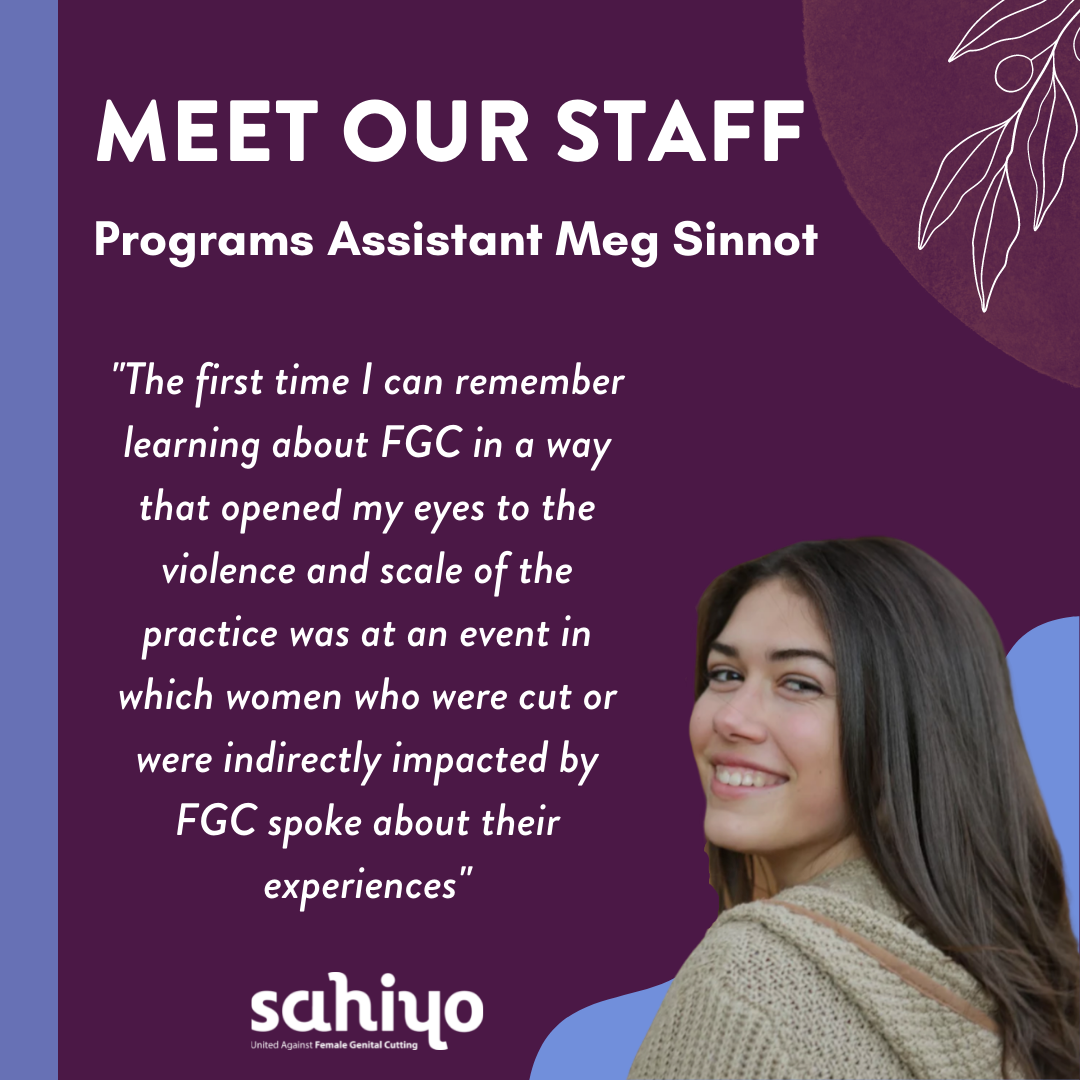Meg recently finished her Bachelor's degree in Sociology and Social Policy at Trinity College Dublin, in Ireland. As a first-generation immigrant born in Switzerland, she has developed a love for learning about different cultures which has led her to become an advocate for the empowerment of minority groups. During her time at college, Meg was an avid member of the Gender Equality Society and coordinated events for the entire university over the course of International Women's Week, including a panel discussion about FGC with the Afro-Caribbean Society. She recently moved to Colorado with her dog Ruby and looks forward to supporting and expanding Sahiyo’s various programs.
What was your experience of learning about female genital cutting (FGC) for the first time?
Interestingly, I must have learned about FGC so long ago that I do not have a specific memory tied to hearing about it for the first time. I think this may be for two reasons. Firstly, in my experience growing up as a woman, gender-based violence was not something that my mother sat down and told me about; instead, it trickled into my subconscious through microaggressions, news stories, and personal experiences. Secondly, as a White Atheist living in Europe, I struggled to understand religiously-rooted gender-based violence. My reaction to learning about FGC was similar to when I learned about women wearing the Burqa from a Western liberal perspective: I saw it only as a way to control women. Due to the inherent racism in framing this issue in such a manner, I was only aware of the existence of Type III FGC and thought that FGC only happened in African countries. Unfortunately, as a result of this belief, I only became aware of the extent and impact of FGC over the last few years, when I learned more about the practice at university.
The first time I can remember learning about FGC in a way that opened my eyes to the violence and scale of the practice was at an event in which women who were cut or were indirectly impacted by FGC spoke about their experiences. This was eye-opening for me because I have always had the privilege of thinking about the impact of FGC in terms of statistics, rather than something that happens to women in real life. Hearing the speakers' personal stories shocked me into understanding the reality of FGC. It is not to say that I had no feelings of sisterhood with women affected by FGC, but through storytelling, I could picture myself as a member of a community practicing FGC in a way that I could not previously. Before, I was afraid to offend those in communities that practice FGC by imposing my White and Atheist viewpoints on them. Listening to women in those same communities condemn the practice showed me that this issue was not one of culture but gender-based violence, control, and child abuse. This realization is what began my path to advocating against FGC.
When and how did you first get involved with Sahiyo?
I first got involved with Sahiyo in March of this year as a staff member. I had just moved back to the United States after graduating from Trinity College in Dublin when I learned about Sahiyo and the valuable work of the team and community against FGC. Throughout my degree in Sociology and Social Policy, I studied women’s issues and knew that I wanted to work to end gender-based violence in any way I could. Since childhood, I have been a writer and storyteller, so Sahiyo’s use of storytelling as activism was compelling. Watching the first few videos on Sahiyo’s YouTube channel of survivors sharing stories crafted through the Voices to End FGM/C Digital Storytelling program had a profound impact on me. Personally, I knew when I graduated that I was looking to join a team that cared about each other and their work. I have definitely found this to be the case working with my team members at Sahiyo!
What does your work with Sahiyo involve?
I am the Programs Assistant at Sahiyo, so my role is to provide administrative, development, and organizational support to the Programs Team on Sahiyo’s numerous programs and projects. Something that I am currently working on that excites me is our latest research project, Critical Intersections, which is in its beginning stages. In my eyes, social research is another form of storytelling. Developing a methodology and survey instrument to acquire data that can help mobilize activists and changemakers is important work that I am proud to be a part of.
How has your involvement with Sahiyo impacted your life?
My involvement with Sahiyo has broadened my perspective on FGC and has also made me a better activist. It is inspiring to work alongside a global network of female activists. Aside from my life being positively impacted by having amazing co-workers, I think of issues from a more intersectional perspective. I was shocked when I found several connections to FGC in my personal life and as a result, I have been making an effort to consider the intersections of identities and the human rights issues that I advocate for.
What words of wisdom would you like to share with others who may be interested in supporting Sahiyo and the movement against FGC?
I would like to share with others that anyone can support Sahiyo and the movement against FGC. You do not need to be a member of the FGC practicing community or a survivor to get involved and make a positive impact; simply having a conversation about FGC with people in your life spreads awareness about the issue and helps to create change. Sahiyo has many fantastic resources to help guide conversations around FGC. In my experience, the more I learned about Sahiyo’s mission and values the more I became interested and involved with all of the programs.

